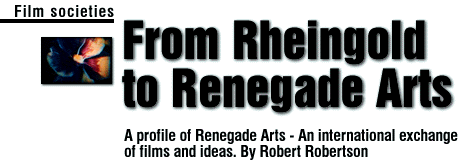A widely circulating idea in the West (the Russians don't appear to subscribe to it) is the concept of the three-minute attention span. It's an idea I've always found unsatisfactory, and, in a way, Renegade Arts is partly based on the idea that there really isn't any such thing.
One of the most popular television programmes today (with an estimated world-wide audience of millions) is a soap opera where all the actors appear to be in a trance-like state, operating on a much slower time-scale than normal, with interminable pauses and long takes on publicity-shot-style faces. Its name escapes me, but it's called something like The High and the Mighty. Each episode is about half an hour long and to me it's living proof that even in the domain of the global mass market, there isn't such a thing as the three-minute attention span. But to return to the subject of this article.
In the early days of the revival of the underground film scene in London, in 1994, Critical Sync was born, set up with the filmmakers Dennis Dracup and Steve Teers. The Critical Sync film screenings were held in the atmosphere-laden premises off Oxford Street, The Rheingold Club. New underground films from Prague, Montr‚al, Trieste, New York, Paris and Moscow, in addition to many newly-created works from the UK was shown, to the accompaniment of the homely reek of grilled bratwurst and sauerkraut emanating from the kitchen behind the screen. Occasionally in the darkness the chef's tall hat could be seen leaning obliquely into a scene of Czech surrealism, as the cook became curious about the strange images unfolding in front of his kitchen. Kurt, the charismatic owner of the Rheingold Club, one of London's oldest nightclubs, had set it up in the fifties, in the style of the German cabaret clubs he had known and loved. It was at the time of these Critical Sync screenings that Claudette Ferry set up Renegade Arts to put on one-person shows and other events at the Rheingold, which drew enthusiastic audiences. Particularly memorable were solo performances by the actors Jack Klaff and John Constable, as well as the successful launch (with live brass ensemble) of the first issue of the poetry magazine Mad Cow, with the poets reading their work.
Critical Sync's models were the open-access, open-submission film screenings in the early 1990s in London, which were part of the Pullit multi-art events, and the freewheeling shows by groups such as the Travelling Cinema (run by Hervé Nahon) and Ken MacDonald's Reel Love screenings, all of them unfunded. The Travelling Cinema in particular often had screenings combined with visual art shows and underground magazine launches. In a similar way the interest in performance evidenced by Renegade Arts had a counterpart in Critical Sync programmes. We showed choreography made specially for film from Paris, films of mime and performance art from Berlin, film created on a pre-existing music score (Empedocles, a collaboration with the artist/filmmaker Dennis Dracup). There were also some very successful combinings of live music and film: the haunting overtone singing of a Tuvan Khoomi musician with an evocative Steve Teers film featuring his visit to Mongolia. On another occasion, the musician Michael Ormiston created an atmospheric improvisation on a Mongolian harp and some Tibetan prayer bowls, for Nada, a semi-abstract film.
Critical Sync, the Cupboard cabaret and the Karney Club (the latter run by Steven Eastwood) filled the club with lively audiences, so we were surprised when a new manager told us that we were not welcome. In the case of Critical Sync our audiences were not buying enough drinks at the bar...
Renegade Arts:+ 44 (0) 181 445 4883
Full article published in Filmwaves - Issue 3, February 1998. Subscribe now!
